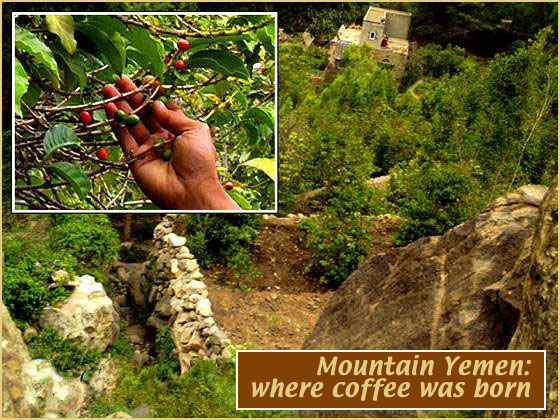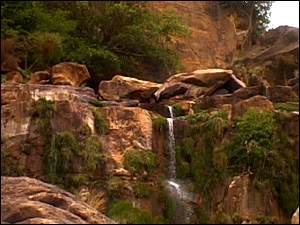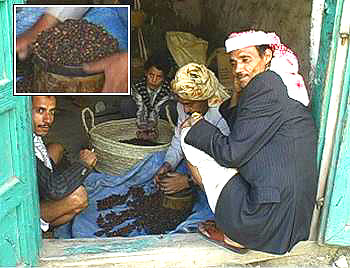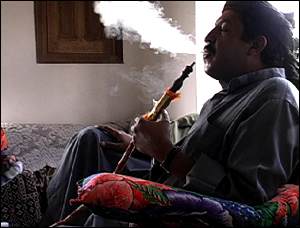|
The land where coffee began...
The region where the coffee plants thrive is fertile with many spring fed waterfalls [above and right]. Qat trees often shade the delicate coffee leaves and the farmers usually live close to their fields.
It has been said that in the 17th Century, Portuguese sailors set anchor in Al Mokha and were treated to the unknown brown liquid which stimulated and invigorated them. They became fond of the beans and took many sacks of coffee back to Europe, where the drink became the rave. By 1616 the coffee trade was so lively that a Dutch visitor to Al Mokha wrote that he saw ... a caravan of a thousand camels packed with coffee... The drink was so popular that the demand forced rapid increases in the price of coffee. This made the farmers and traders of coffee very wealthy. Many mansions and palaces were constructed in this region in the 1700's.
Eventually, the demand for coffee encouraged the smuggling of the beans to Ceylon, where they grew well. The bean has since found homes all over the globe but the original coffee, called mocha, is still revered as a top shelf brew.
Yemeni beans have a unique flavor that comes from the height of their gardens -- some 3000 meters above sea level. The thin atmosphere and the strong sunlight combine to make an irresistible flavor when the beans are roasted. The small size of this crop makes it a rare treat -- even in Yemen.
|
|
Coffee grows very well in the region and the raw or roasted beans are sold in a special section of the suq. This is where Yemeni households buy their finest coffee. The entire region of Harraz was once exclusively devoted to coffee while today other crops like qat are also grown. Most of Yemen's coffee is exported and is considered the best coffee in the world. Small quantities make it to the domestic market and even less coffee makes it to the local restaurants. If you can find it, Yemeni coffee is unforgettable.
|
|
If you are offered a coffee in any of the roadside eateries, it will likely be made from brewed coffee shells and sweetened with a little sugar and ginger. It's more of a tea, really, and will give you the caffeine without the familiar bitter taste of regular coffee.
The next step up is Nescafe instant coffee, which seems to be served frequently with condensed milk. You get used to it pretty quickly and it does pack a good dose of caffeine. But there's nothing like a good fresh cup of coffee.
You can find the real Yemen coffee in many hotels, especially the small ones. In Sana'a we frequented the Golden Dar Hotel and enjoyed small pots of strong, freshly brewed Joe. They served it with hot milk. The price was about 400 Ryals and served 4 small cups.
In many restaurants there is a lounge area on the upper floor. As the sun gets hot you can be sure to find relief in these comfortable vistas. We almost always met other travelers in these lounges and we shared stories and traded e-mail addresses over coffee, qat, shai and tobacco hookas.
|

 Al Mokha is credited as the home of coffee, but the best coffee beans are grown many miles inland, on the high mountain terraces. The trees are pampered, individually cared for by local farmers and grown with rainwater irrigation, without the use of chemicals.
Al Mokha is credited as the home of coffee, but the best coffee beans are grown many miles inland, on the high mountain terraces. The trees are pampered, individually cared for by local farmers and grown with rainwater irrigation, without the use of chemicals. The many small towns share a common market, or suq. The suq closest to Hajarrah was in the village of Manakaha. It was small but very busy suq. Grains, including millet, rye, wheat, barley, lentils and beans were sold by street vendors who brought their produce from remote farms.
The many small towns share a common market, or suq. The suq closest to Hajarrah was in the village of Manakaha. It was small but very busy suq. Grains, including millet, rye, wheat, barley, lentils and beans were sold by street vendors who brought their produce from remote farms. 